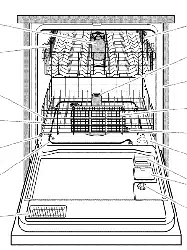Loading ...
Loading ...
Loading ...

Additional efficiency tips
• To save water and energy and time, do not rinse dishes
before putting them into the dishwasher.
• Use a low energy, quick, or short cycle whenever possible.
These cycles use less hot water and energy than a normal
cycle.
• Use a delay feature (on some models) to run your dishwasher
during off-peak hours. Local utilities recommend avoiding
heavy usage of energy at certain times of day.
• During the summer, run your dishwasher at night. This
reduces daytime heat buildup in the kitchen.
• Use the energy-saving dry option whenever possible. Allow
longer drying times (overnight) when using these options. Use
a rinse aid to improve drying.
• Use cycles or options that add extra heat to the wash or rinse
portion of the cycle only when needed.
• Run your dishwasher with full loads. Run a rinse cycle after
meals until the dishwasher is full.
• If your home is equipped with a water softener, you may want
to avoid starting the dishwasher during the regeneration of
the softener, since this may contribute to poor wash
performance.
Select the wash cycle. Ifthe door is latched, you will hear the
cycles start and stop as the cycle control knob passes each cycle
mark. This is normal and does not hurt the dishwasher. If you
prefer, you can set the cycle control knob with the door
unlatched.
NOTE: Use the Air Dry option with the Rinse Only cycle.
Turn the cycle control knob to the desired cycle.
A "O" shows what steps are in each cycle.
Water usage is shown in U.S. gallons/liters.
Cycle time includes dry time.
HEAVY WASH
Use this cycle for loads with heavy food soil.
Use both detergent dispenser sections.
Pre- Rinse Rinse Main Rinse Final Dry Time Water
Wash Wash Rinse (rain) Usage
(gal/L)
• • • • • • 90 7.2/27.2
POTS & PANS
Use this cycle for hard-to-clean, heavily soiled pots, pans,
casseroles, and regular tableware.
Use both detergent dispenser sections.
Pro- Rinse Rinse Main Rinse Final Dry Time Water
Wash Wash Rinse (rain) Usage
(gal/L)
• • • • • • • 98 8.6/32,7
NORMAL WASH
Use this cycle for loads with normal amounts of food soil. (The
energy-usage label is based on this cycle.)
Use both detergent dispenser sections.
Pre- Rinse Rinse Main Rinse Final Dry Time Water
Wash Wash Rinse (rain) Usage
(gal/L)
• • • • • 85 5,7/21.8
RINSE ONLY
Use this cycle for rinsing dishes, glasses, and silverware that will
not be washed right away.
Do not use detergent with this cycle.
Pre- Rinse Rinse Main Rinse Final Dry Time Water
Wash Wash Rinse (rain) Usage
(gal/L)
• • 20 2.9110.9
10
Loading ...
Loading ...
Loading ...
